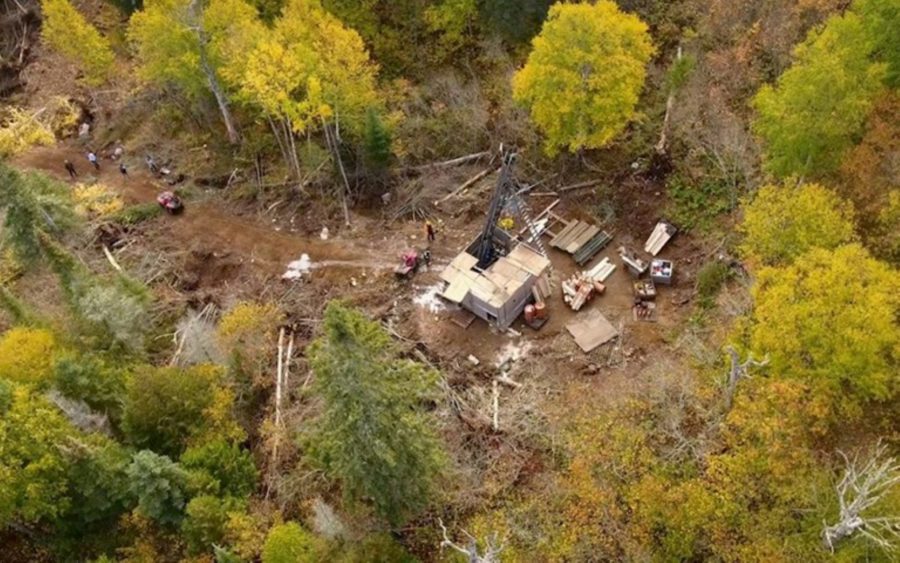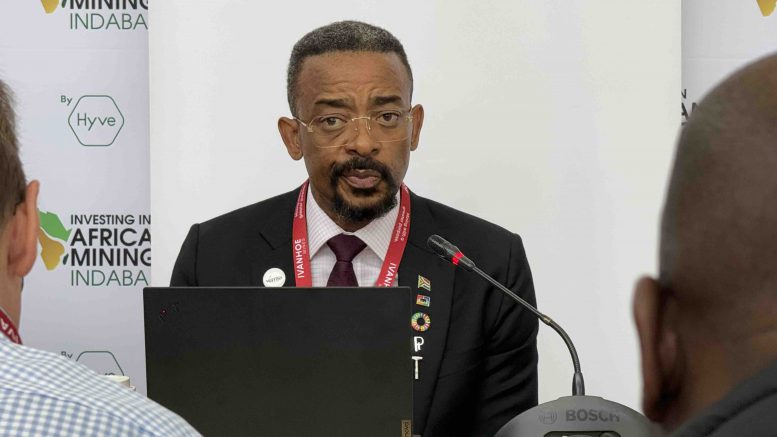Look who’s all grown up
Anyone who attended the PDAC convention in Toronto in early March is aware that opportunity is not only knocking in this business but trying to break down the door. There was record-high attendance; warm bodies with any technical credentials were being offered jobs, and this hasn’t always been the case. High metal demand and strong prices, and a return of investors to the junior mining sector are the reasons behind today’s boom.
This is the kind of market that a smart company can use to its advantage, especially if it has established expertise, and the right commodities to sell. Dynatec is such a company. The Richmond Hill, Ont.-based mine services company turns 25 this year, and it is turning heads.
The innovative company has found a unique way to break into the mining ranks. There are over 1,200 Canadian companies listed in the 2004-05 edition of the Canadian & American Mines Handbook, of which probably a thousand are hopeful of someday owning a mine. There are nine mining contractors currently listed in CMJ‘s online Buyers Guide. Dynatec is the only company that is both a contract miner and a mine owner/operator.
To find out how this came to be, and where Dynatec is heading, we talked to president and CEO Bruce V. Walter and his predecessor W.R. (Bob) Dengler.
Growth by steps
Dynatec Mining Ltd. was founded in 1980 by three engineers–Bob Dengler, Bill Shaver and Fred Edwards–of whom only Bob Dengler remains with the company, as vice-chair. He handed over his role as president and CEO on January 1, 2005, to Bruce Walter.
Initial growth was slow. In 1988 Dynatec took over a drilling company, Tonto, becoming Dynatec International Ltd. with two divisions: Mining Services and Drilling Services.
Big changes came in 1997. Dynatec obtained Sherritt International Consultants Inc., based in Fort Saskatchewan, Alta., with 50 years of experience in metallurgy. It has participated in the commercialization of more than 40 hydromet plants worldwide, 15 plants of which produce nickel and cobalt, including Moa Bay in Cuba, a key nickel laterite success story, where the plant currently runs well over design capacity. This business became the Metallurgical Technology division of Dynatec. The same year the company went public through an initial public offering, with common shares of Dynatec Corp. listed on the Toronto Stock Exchange.
According to Dengler, “Dynatec had a vision of mine ownership a long time ago. When the company was first formed we focused on underground development work and shaft sinking. During years of mining we have operated in virtually every commodity minable. As we expanded we began running small mining operations, gradually building up to larger, more comprehensive projects such as Inco’s Shebandowan nickel mine, the Ken Snyder gold mine in Nevada and Goldcorp’s Red Lake gold mine. From geology and mine development through to mine management, we can take on a project and bring it through to a producing mine. When we added our Metallurgical Technology division in the late 1990s we realized we could leverage our expertise to add greater value for our shareholders through mine ownership.”
As an early foray into mine ownership, Dynatec bought an interest in Canadian industrial mineral producer Highwood Resources in 1999, which was increased to 100% in 2002. This is now referred to as the Mineral Products division.
The more substantial leap into mine ownership came when the company formed the Sudbury Basin Joint Venture (SJV) with FNX Mining Co. Inc. in February 2002. The SJV would earn 100% interest in the mineral property rights of five formerly producing nickel-copper mines in the Sudbury Basin from Inco Ltd., by spending Cdn$30 million on exploration and development work. (Dynatec owns 25% of the properties and is the mine operator while FNX has a 75% interest and handles the exploration. Inco has the right to process all the ore mined from these properties.) The intention was to develop and operate at least four of these properties.
“Frequently junior companies are exploration-centric, and have no in-house expertise to bring a mine into development,” says Walter. “Because of the consolidation among the majors, the size of the projects they’re interested in has risen. Juniors have smaller-sized projects, and that has created opportunities for us. We have the financial capital and operating expertise to move projects like these forward. In the case of the Sudbury Joint Venture, Inco wanted FNX to find a partner with mining expertise.” Dynatec was that partner.
The joint venture’s first project, the McCreedy West mine, began to produce in May 2003 and declared commercial production in November 2003, making Dynatec and FNX base and precious metal producers for the first time. For more about the Sudbury Joint Venture see the article on page 14 of this issue. Interesting drill results were recently announced from the North Range footwall, which is close to the Levack shaft, adding more luster to the properties. “We would like to make more joint ventures like this,” says Walter.
Dynatec moved into the energy sector in April 2003, leasing the coal-bed methane rights to more than 17,000 ha in West Virginia, over coal seams known to have significant potential for quality coal-bed methane production. Dynatec intended to use its drilling expertise to become a natural gas producer. A pilot program was completed in mid-2004, including drilling, core sampling, desorption, formation and flow testing. The preliminary gas-in-place estimate is 1.8 billion m3. Drilling of the first pair of pilot wells was completed around the end of 2004. The second pairing is almost finished, and work is underway on additional pairs. The plan is to establish commercial production rates during 2005, and then decide whether or not to stay in the coal-bed methane business.
Dynatec’s revenues of Cdn$151.9 million in 2003 were enough for the company to place 27th among Canadian mining companies in 2003 (see “Canada’s Top 40”, CMJ Aug-Sept 2004).
At the end of 2004 the company decided to sell its Drilling Services and Mineral Products divisions. It announced in February 2005 the sale of Drilling Services to a subsidiary of Major Drill Group International Inc. for US$17.2 million; Mineral Products is still on the block.
The intention to sell these two divisions forced the company to restate its financials. The restated revenue for 2003 was Cdn$106.7 million; this rose to $148.9 million in 2004.
The lion’s share of the revenue last year ($128.4 million) came from Mining Services of which about one third is from the SJV. As an owner, Dynatec received an additional $16.1 million revenue from the SJV. The third stream of revenue came from Metallurgical Technologies ($4.4 million). Restated operating earnings went from a loss of $1.1 million in 2003 to earnings of $4.4 million in 2004; mine services and metallurgy continued to be profitable but, significantly, $6.8 million of the earnings came from the SJV, in its first year of commercial production. With completion of the sale of Drilling Services on March 15, 2005, the company now has about $50 million in cash.
There are 1,100 employees in the company, now that Drilling Services is sold. A thousand work in Mining Services, including 300 on the SJV and over 300 at the Red Lake mine. Sixty work in Metallurgical Technology, and 40 are in head office and on the Ambatovy project, which looks like it will soon become the largest part of the company.
Ambatovy–a company-maker
In August 2003, Dynatec ventured outside of Canada, through an agreement with Phelps Dodge Corp. to evaluate, develop and operate the very large Ambatovy nickel/copper laterite project in Madagascar. “Ambatovy is now our largest property,” says Walter. “It is a major expansion for us.
Most of the risks had already been taken care of, but Phelps Dodge needed a partner with nickel metallurgy expertise. We thought it was one of the best nickel projects in the world.”
The initial agreement allowed Dynatec to earn 53% interest by spending US$20 million on the project and providing commercial licences for its hydrometallurgical technology. A January 2005 agreement increased Dynatec’s interest in Ambatovy to 100%, giving Phelps Dodge 20.9 million Dynatec shares (9.9% of the company’s equity) and 100 preferred shares of a Dynatec subsidiary.
In late February the results of the feasibility study on Ambatovy were released. The study was coordinated by SNC-Lavalin Engineers & Constructors Inc.
The plan is for an open pit mining operation from two deposits 3 km apart, Ambatovy and Analamay. There is 1 m of overburden to be removed. The laterite ore is unusually thick–40 m on average. No blasting is necessary in the soft ore. Proven and probable reserves are 125 million tonnes grading 1.04% Ni and 0.099% Co using a 0.8% Ni cutoff, and there is potential for more. The strip ratio of waste and low-grade material to ore will be 1.33:1 over the mine life.
An ore preparation plant at the mine site will slurry the laterite ore, which will be delivered via a 195-km-long pipeline to a selected pressure acid leach process plant near the port of Toamasina. This plant will produce a mixed sulphide product containing on average 55.2% Ni and 4.2% Co. Test results showed nickel and cobalt extractions of more than 95%, excellent ore settling behaviour, low acid consumption (220 kg/tonne for primary limonite ore), high leach residue settling densities and low leach retention times (75 minutes). A conventional refinery near the process plant will extract the nickel and cobalt.
The plant will be designed with a capacity of 60,000 tonnes of LME Class 1 nickel metal, 5,600 tonnes of cobalt and 186,000 tonnes of ammonium sulphate. (This is similar to the nickel production expected at Inco’s Goro project in New Caledonia.) The project life will be 27 years, including 20.5 years of mining and a further 6.5 years of processing from a low-grade stockpile. All metallurgical processes recommended for Ambatovy have already been successfully applied at other sites on a commercial scale.
The base case capital cost for the Ambatovy project is estimated at Cdn$2.25 billion, including the mine and preparation plant, slurry pipeline, process plant, refinery and offsite infrastructure. The cash operating costs are estimated to be among the lowest in the world, at US$0.67/lb Ni after credits for the first 10 years. The base case pricing is US$3.50/lb for nickel and US$10/lb for cobalt; this would yield an after-tax, all-equity rate of return estimated at 11.1%. If the pricing used were the average metals prices from 1980 to 2003 (US$4.07/lb for nickel and US$18.65/lb for cobalt), the rate of return would rise to 16.4%. This mine should be making money even if the nickel price drops as low as US$1.70/lb.
Ambatovy is a large, expensive project for any mining company, especially one with a market capitalization of only about Cdn$240 million. For this reason, Dynatec is in discussion with base metal producers and nickel consumers, looking to add one or more equity partners in the project. Walter says the strength of both the project and the metal markets have resulted in considerable interest already, and the positive business atmosphere in Madagascar also helps.
The new Dynatec is following its strategy of creating shareholder value by applying its mining and metallurgical expertise to attractive projects as an owner/operator. With its level of experience and property portfolio, Dynatec has better than even odds of succeeding in its next quarter century.





Comments